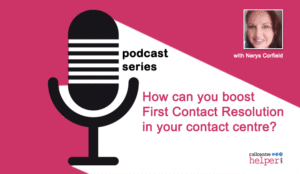Time to Resolution is an essential metric in call centres that measure the average time between creating the customer interaction and when labeling that interaction Resolved.
This metric helps gauge the support team’s ability to resolve customers’ issues. This article offers you all the information you need about Average Resolution Time (ART) and how to reduce it with nine proven tips for the call centres.
What Does Average Resolution Time (ART) Mean?
Average Resolution Time (ART) or Time to Resolution or Mean Time to Resolution (MTTR) is the average time call centre agents take to solve opened tickets in a specified period.
The average resolution time in call centres varies depending on the complexity of the service issue and the ratio of available call centre agents to queued tickets for the given period.
If the Average Resolution Time (ART) increases, the call centre manager should investigate the underlying problem and try to solve it.
It could mean that the support crew needs more aid and training to deal with increasingly complicated client concerns or that there is a lack of coordination between the support team and those brought in to help with complex problems, such as engineering challenges.
How Can Average Resolution Time (ART) Help the Call Centre?
During the life cycle of a ticket, there may be various resolution timeframes. For example, the First Resolution Time is the time between when a ticket is formed and when the ticket’s first timestamp is marked as solved.
In contrast, the Full Resolution Time is the time between when the ticket is created and when the ticket’s most recent timestamp is recorded as solved.
When a ticket is reopened, the time it takes to resolve it ultimately increases. However, when clients are given considerable time to reopen a ticket after it has been tagged as solved, the First Resolution Time may be preferred.
These two resolution times should be as close together as possible. For example, maintaining a low Full Resolution Time close to First Resolution Time indicates that the support team resolves issues the first time they arise.
If the period between resolutions is excessively long, the manager may need to increase Next Issue Avoidance.
This indicator measures how often consumers experience several issues in a specific time frame.
Assume a customer’s ticket has been resolved and the First Resolution Time has passed.
Despite this, it has reopened and will continue due to a problem unrelated to the original. The Full Resolution Time is then extended.
While the ticket was open and the initial issue was being investigated, perhaps the agent could use the opportunity to highlight any additional difficulties the customer had that, in the meantime, were lost.
Being tagged as pending and on-hold during the lifecycle of a ticket will also affect the time it takes to resolve it.
Pending indicates that you are waiting for a response from the client before proceeding, whereas on-hold indicates that you are awaiting input or Resolution from a third party.
Because pending and on-hold tickets have the potential to increase resolution times and are often triggered by circumstances outside the manager’s control, the manager may wish to consider screening them out.
How to Calculate Average Resolution Time?
Customer satisfaction is always determined by how quickly a problem is resolved. At the contact centre, every consumer wants a timely and consistent response.
It’s critical to respond to customers’ concerns in real-time if you want to keep them from abandoning the call centre.
The average resolution time (ART) is the time the team takes to resolve a support ticket once it has been reviewed.
It occurs over hours or days. Customer satisfaction is higher when the resolution time is short.
How can you figure out how long it takes to resolve a problem on average? The Average Resolution Time (ART) formula is as follows:
Average Time to Resolution = Sum of all times to resolution/total # of cases resolved.
Using the basic technique above, you may evaluate customer service.
You must divide the number of cases resolved by the sum of all times to Resolution. For example, this displays the support team’s Average Resolution Time (ART).
It would be beneficial if you had high-quality software to provide excellent customer service and reduce the call centre’s average resolution time.
Customer satisfaction is high when the average resolution time is short. However, when the resolution time is longer, it shows a more excellent FCR, which means fewer customer encounters are required to fix the problem.
How to Reduce Resolution Time in Call Centres?
Unlike a phone call, when each support agent is assigned to only one conversation at a time, web chat agents are typically assigned to up to three chats simultaneously.
This significantly impacts the Average Resolution Time (ART) indicator, which measures the length of client contact.
ART, supervisor escalations, no response past a certain time threshold, a fixed internal knowledge base (IKB), and process inefficiencies are all affected by the same factors that affect Average Handle Time (AHT) on a call.
It would help if you first tracked the most important KPIs that determine overall resolution time to enhance average call centre resolution time.
You may better personalize teaching programs, provide feedback on the product, and uncover any operational inefficiencies that impair an agent’s ability to complete the jobs by monitoring these KPIs on 100 percent of client live chat engagements.
Now let us look at some tips to reduce the resolution time in a call centre:
Use Top Support Tools
The call centre equipment for every agent usually includes:
- A computer,
- A headset,
- A reliable internet connection,
- A software with the capability of automated and predictive dialling.
Aside from the hardware, try to provide an elite helpdesk for an effective resolution strategy. First, customize the support metric in the primary ticket funnel.
Train Call Centre Agents With De-escalation Techniques
Supervisor escalations significantly increase resolution time; therefore, teaching support employees to successfully de-escalate in a call centre is crucial.
Managers can better equip agents to de-escalate challenging situations by knowing which macros work best, regularly updating IKB (content and navigation), and deleting unnecessary workflows.
Improve Contact Centre Agents’ Empathy
Agent empathy is an essential soft skill for call centre staff. Agent empathy, driven by empathy statements, improves the connection between agents and consumers, allowing them to create rapport.
It also demonstrates that the agent genuinely cares about the consumer, leading to a better customer experience and, as a result, more earnings.
Client service and outbound sales teams should monitor empathy statements in every customer interaction, review their impact regularly, and train workers on how to use them.
Consider Long-Standing Tickets
No matter how great the support, call centre agents eventually run into the complex tickets that create skewed data.
Either the ticket sat pending and was never answered, or it was never labelled Resolved. Make sure to filter and address these so the aggregated metrics are not off.
Reduce Dead Air on the Agent’s Part
When a call centre agent stops talking during a conversation with a customer, dead air happens on the call.
When a call centre agent stops responding to a customer, it frustrates the customer. The secret is keeping the customer engaged and persuading them that agents care about their time.
Standard methods for controlling dead air include:
- Providing reasons for waiting to manage customer frustration,
- Leveraging auto-responders with FAQ pages or intake forms,
- Frequently informing customers about progress,
- Using appropriate phrases for the call centre.
Improve Internal Knowledge Base (IKB)
The Internal Knowledge Base (IKB) is a reference hub for agents that is easy to use.
However, it is vital to ensure that agents are adequately trained on how to utilize it and that it is regularly updated with new information and assets to help agents handle consumers more efficiently.
Check Every Call Centre Agent’s Performance
Dig into every agent’s unique numbers to have more granular information and know Resolution by employee.
This allows you to see which call centre agents are more efficient and where you need more training and coaching for the agents.
Coach for a One-Call Close
Web chat is an active, accessible, and proactive sales channel that is reliable for high-volume sales.
You should know what chat representatives are doing, leading to the one-call-close to increase the Average Resolution Time (ART) measure.
It includes:
- Contact centre agents can ensure that they are using sales scripts and control the impact and surface areas of improvement.
- They can close more businesses by leveraging data and information in chats to provide more personalized support.
- They know what to coach on and can control agent improvement from day one in the call centre.
Control the Call Centre Quality | Average Resolution Time (ART)
Now it is time to do a quality check in the call centre to understand a complete picture of performance other than the number of closed tickets.
If you do a quality check, you will understand if you are meeting customers’ expectations rather than trying to move on to the next issue.
Checking Net Promoter Score (NPS) and other customer satisfaction factors can complement this strategy.
The Average Resolution Time (ART) is a critical indicator for measuring call centre agent performance. It also identifies areas where internal workflows and processes could be improved.
This post included nine tried-and-true suggestions for reducing this time in your call centre.
For more information about Scorebuddy - visit the Scorebuddy Website
Call Centre Helper is not responsible for the content of these guest blog posts. The opinions expressed in this article are those of the author, and do not necessarily reflect those of Call Centre Helper.
Author: Scorebuddy
Published On: 30th Jun 2022 - Last modified: 28th Apr 2023
Read more about - Guest Blogs, Scorebuddy






 Scorebuddy is quality assurance solution for scoring customer service calls, emails and web chat. It is a dedicated, stand-alone staff scoring system based in the cloud, requiring no integration.
Scorebuddy is quality assurance solution for scoring customer service calls, emails and web chat. It is a dedicated, stand-alone staff scoring system based in the cloud, requiring no integration. 









